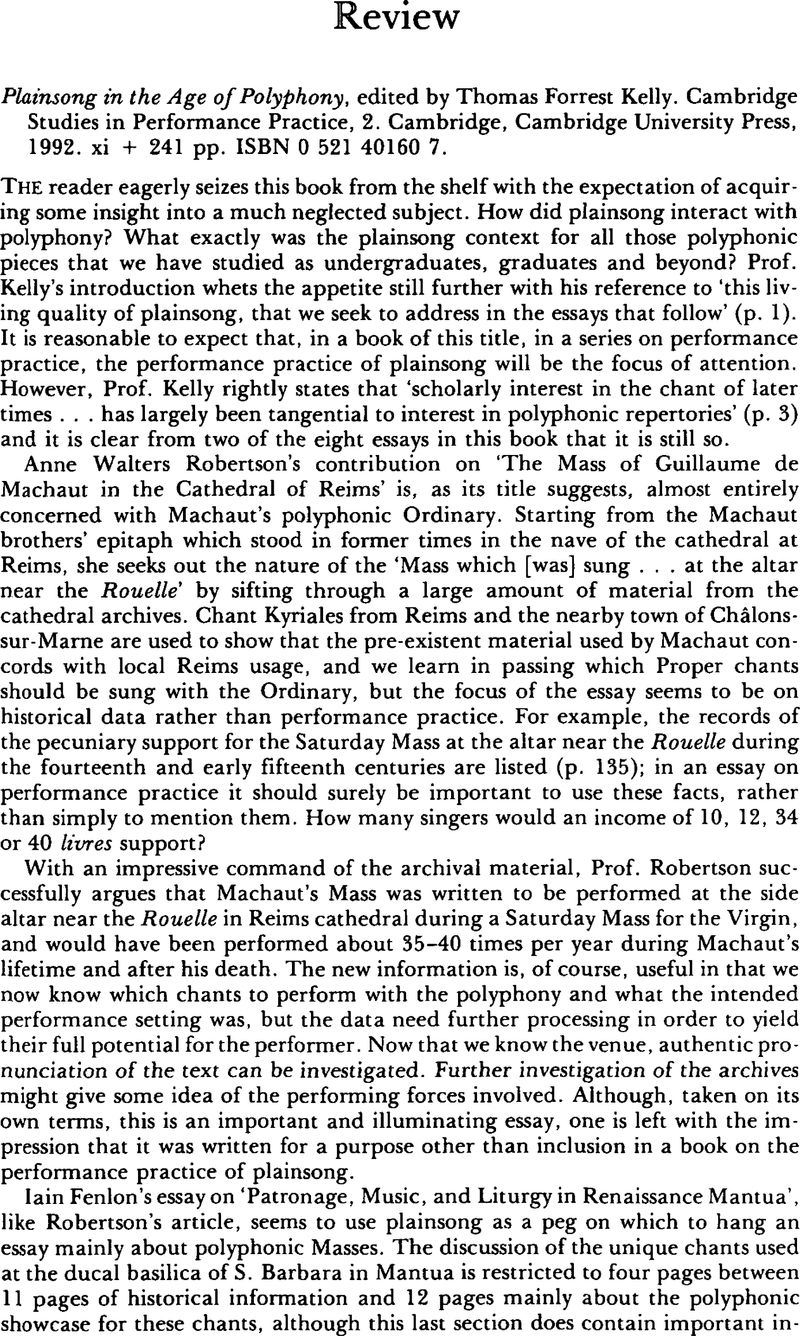No CrossRef data available.
Article contents
Plainsong in the Age of Polyphony, edited by Thomas Forrest Kelly. Cambridge Studies in Performance Practice, 2. Cambridge, Cambridge University Press, 1992. xi + 241 pp. ISBN 0 521 40160 7.
Review products
Published online by Cambridge University Press: 01 January 2020
Abstract

- Type
- Review
- Information
- Copyright
- Copyright © 1993 Royal Musical Association
References
1 Mantua, Archivio Storico Diocesano, Archivio della Basilica di Santa Barbara, MS 1.Google Scholar
2 For example, Percy A. Scholes, The Concise Oxford Dictionary of Music (Oxford, 1964), 355: ‘the Ordinary of the Mass, or Common of the Mass, i.e. the invariable part’; Donald J. Grout and Claude V. Palisca, A History of Western Music (4th edn, London, 1988), 47: ‘The invariable parts of the service are called the Ordinary of the Mass …, and include the Kyrie, Gloria, Credo, Sanctus, Benedictus, and Agnus Dei.‘Google Scholar
3 Hughes, Andrew, Medieval Manuscripts for Mass and Office (Toronto, 1982), 95.Google Scholar
4 See the discussion in Theodore Karp, ‘Towards a Critical Edition of Notre Dame Organa Dupla’, Musical Quarterly, 70 (1966), 350–67 (p. 362).Google Scholar
5 Die Quellenhandschriften zum Musihtrahtat des Johannes de Grocheio, ed. Ernst Rohloff (Leipzig, [1972]), 124, cited by Caldwell on p. 10.Google Scholar
6 See GB-Lbl Add. MS 4911, f. 103v.Google Scholar
7 Richardinus, Robertus, Commentary on the Rule of St Augustine, ed. George Gordon Coulton (Edinburgh, 1935). 80.Google Scholar
8 Strohm, Reinhard, Music in Late Medieval Bruges (Oxford, 1985), 40–1.Google Scholar
9 Edmond vander Straeten, La musique aux Pays-Bas avant le XIXe siècle, 8 vols. (Brussels, 1867–8), iii, 187; cited by Bloxam, p. 168.Google Scholar
10 Mother Thomas More, ‘The Performance of Plainsong in the Later Middle Ages and the Sixteenth Century’, Proceedings of the Royal Musical Association, 92 (1965–6), 121–34 (p. 125).Google Scholar
11 Richardinus, Commentary, 80.Google Scholar
12 Major, John, In quartum sententiarum (Paris, 1516), f. ccliii.Google Scholar
13 Knowles, Gerald, Patterns of Spoken English (London, 1987), 91–2.Google Scholar
14 Dom Eugène Cardine, Sémiologie grégorienne (Sablé-sur-Sarthe, 1970), 38.Google Scholar
15 Ibid., 48–55.Google Scholar


